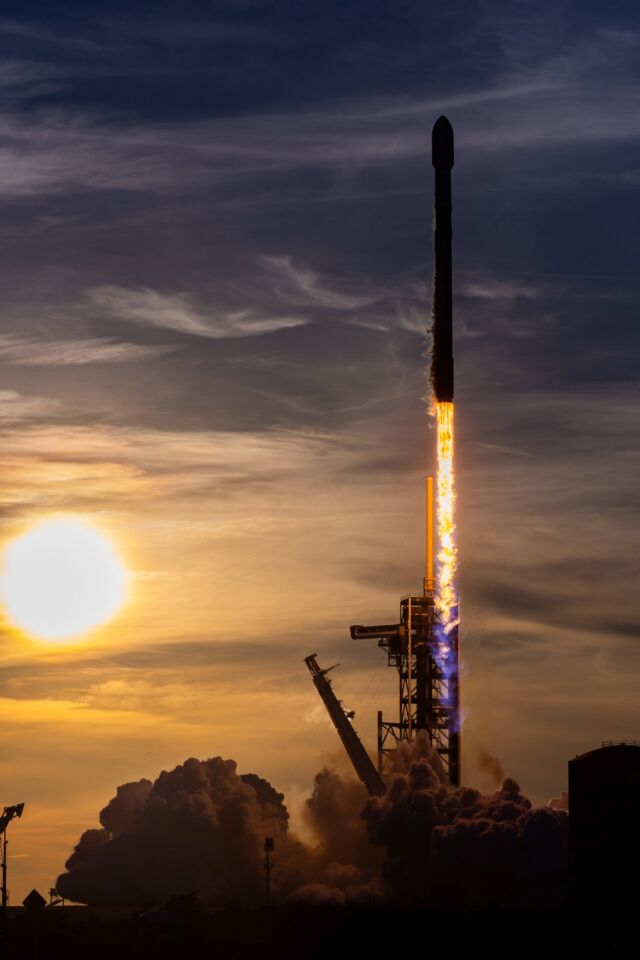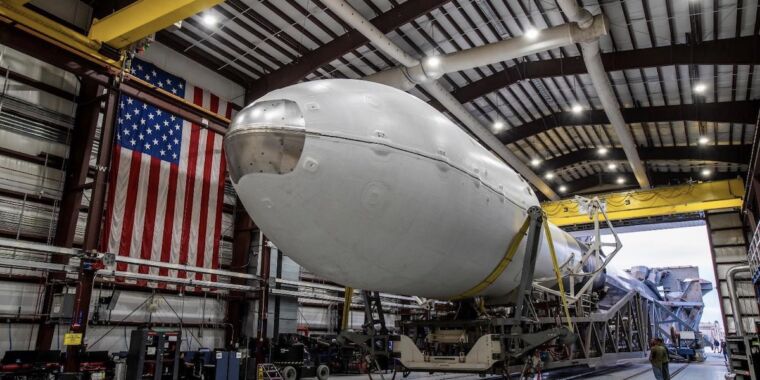In a first, SpaceX will launch one of its reusable Falcon 9 boosters for the 20th time on Friday night on a flight to deliver 23 additional Starlink internet satellites into orbit.
This historic mission is scheduled to lift off at 9:22 PM EDT Friday (01:22 UTC Saturday) from Space Launch Complex 40 (SLC-40) at Cape Canaveral Space Force Station in Florida. Meteorologists from the US Space Force are predicting “excellent” weather for the prime-time launch.
Falcon 9 will carve a familiar path through space, following the same profile as dozens of previous Starlink missions.
The rocket's first stage booster will shut down Merlin's nine kerosene-fueled engines after about two and a half minutes of flight, reaching a top speed of more than 5,000 mph (8,000 km/h). The first stage will be separated from the Falcon 9 rocket's upper stage, which will continue to launch into orbit. Meanwhile, the 15-story-tall Falcon 9 rocket will follow a curved trajectory before braking for a vertical landing on a drone ship floating in the Atlantic Ocean near the Bahamas.
The 23 flat-top Starlink spacecraft will deploy from the upper stage just over an hour after liftoff, bringing the total number of Starlinks in low Earth orbit to more than 5,800 spacecraft.
Hunger to get going
Almost every day, SpaceX launches a rocket or rolls one out of the hangar and onto the launch pad. At this pace, SpaceX is redefining what is routine in the space industry, but its rapid launch rate also means the company is constantly breaking records, most of them its own.
Friday night's launch will break another one of those records. This first-stage booster, designated with tail number B1062, has flown 19 times since its maiden flight in November 2020. The booster will now be the first in SpaceX's inventory to lift off on its 20th flight, breaking a tie with three other company fleet leader rockets.
When SpaceX debuted the newest version of the Falcon 9 rocket, the Falcon 9 Block 5, officials said the reusable first stage could fly 10 times with minimal refurbishment and possibly additional flights with a more extensive overhaul. Now, SpaceX is certifying Falcon 9 boosters for 40 flights.
This particular missile has not undergone any extended maintenance or long-term idling. It has flown an average of once every two months since its debut three and a half years ago. So SpaceX's milestone of 20 flights on Friday night means that this rocket has doubled its original design life and, at the same time, has reached the halfway point of its extended service life.
During its career, this rocket launched eight people and 530 spacecraft, most of them Starlink. The rocket's first two flights launched GPS navigation satellites for the US Army, and then launched two commercial human spaceflight missions using Dragon crew capsules. This was the all-private Inspiration4 mission and the Axiom 1 mission, the first all-commercial crewed flight to the International Space Station.

Remarkably, this will be the sixth launch of a Falcon 9 rocket in less than eight days, more flights than SpaceX's main US competitor, United Launch Alliance, has launched in 17 months.
This will be the 38th launch of a Falcon 9 rocket this year and the 111th flight of a Falcon 9 or Falcon Heavy rocket — SpaceX's 114th launch overall — in the last 365 days. More than a third of SpaceX's Falcon 9 or Falcon Heavy missions, which will reach 332 after Friday night's flight, were launched last year.
This month, SpaceX demonstrated, for the first time, the ability to launch two Falcon 9 rockets in less than five days from the company's launch pad at Vandenberg Space Force Base in California. SpaceX also reduced the time needed between Falcon 9 rockets at Launch Complex 39A at NASA's Kennedy Space Center. The company's most widely used launch pad, the SLC-40, can handle two Falcon 9 flights in less than four days.
It's not just about the launch pad transformation. SpaceX is using its drone ships — two in Florida and one in California — for most Falcon 9 landings. In order to meet the desire for Falcon 9 launches, SpaceX is working to return rockets to port and redeploy drone ships at sea at a faster rate.

“Typical beer advocate. Future teen idol. Unapologetic tv practitioner. Music trailblazer.”






More Stories
‘It gave me goosebumps’: The most powerful gamma-ray burst ever observed was hiding a secret, scientists say
NASA’s Perseverance rover has found a rock on Mars that may indicate ancient life.
Northern Lights May Shine in Some States Tonight